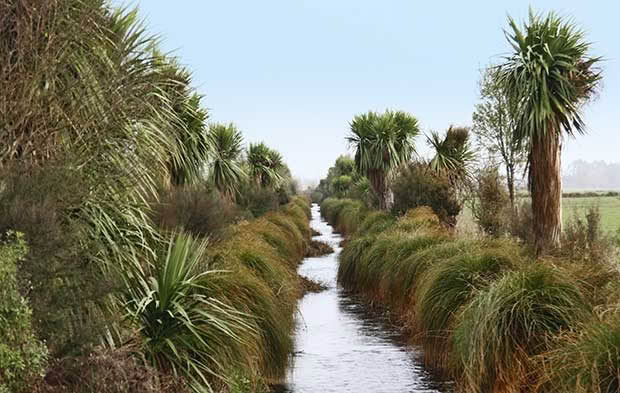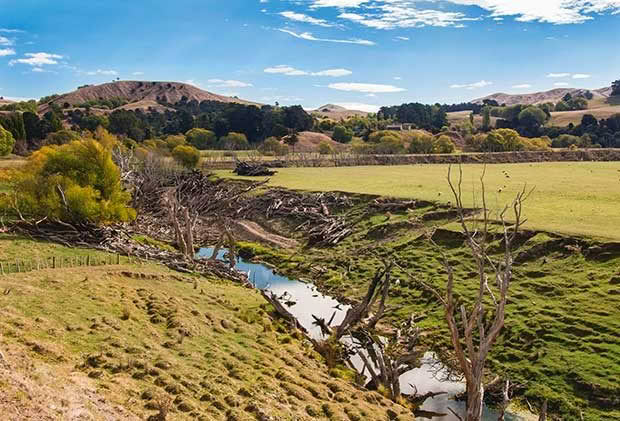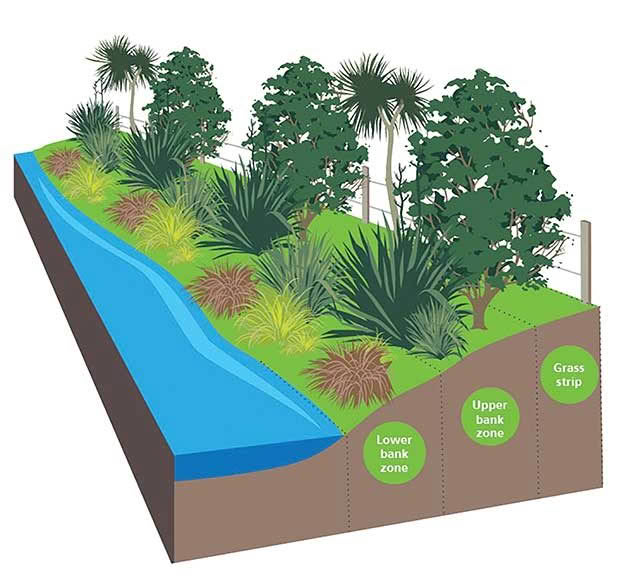How riparian design can protect New Zealand waterways and improve property value

It’s an investment in something beautiful and it works 24 hours a day, 7 days a week, forever.
Words: Abby Matthews
Riparian zones (or margins) are areas of land next to drains, small streams or rivers, and surrounding lakes.
Planting and managing these areas, helps to protect their natural habitat and enhance water quality, the home to numerous native fish, birds and insects. If well-designed and managed, they can be a valuable asset for your farm and look great too.
One of the key challenges is managing nutrients in our rivers, lakes and estuaries. Bacteria and nutrients (nitrogen and phosphorus) make their way into waterways through run-off and discharges, and can also be transported through soil and groundwater.
Riparian planting alone is unlikely to remove all nutrients, but it is an important part of your management toolbox.
3 BENEFITS OF PLANTING AROUND WATERWAYS
Generally, nutrients have the greatest impact during summer when river flows are low and nutrient concentrations are high. Sunlight, warmer temperatures, slower flow and nutrient-rich water reduce the habitat available to insects and fish species that prefer cooler, clean, fast-moving water. These conditions also promote the growth of nuisance algae which can smother gravel-bed rivers and streams and contribute to algal growth.

Pest willows being removed from beside a water. Fencing a waterway like this will stop stock from entering water, but also reduces erosion, helping to stabilise banks, and provides a buffer where nutrients can be caught and removed by plantings.
A well-designed riparian margin has a multitude of benefits:
• planting creates shade and shelter for fish and insects, moderating water temperature;
• it reduces erosion by slowing run-off, stabilising banks and trapping sediment, which can help with flood control and improve water clarity;
• minimising sediment also reduces phosphorus, benefitting our waterways by limiting the growth of nuisance algae, improving habitat for aquatic life and making our waterways more pleasant for swimming and fishing.
Flow-on benefits include reduced costs associated with drain clearing, and water filtration and treatment.
WHY GOOD PLANNING SAVES YOU MONEY
To get the most out of your riparian planting, it’s best to do your research before you pull out the credit card. Planning should cover everything from design right through to fencing, plant selection, weed control and maintenance.
Your local council may have rules about work that can and cannot be done near a waterway, particularly if you are in a flood control or drainage scheme area. Seek advice before undertaking any work as this can save you time and money in the long run.
Give consideration to local conditions when planning your riparian planting. This includes exposure of plantings to high winds, sea spray and frost, and whether the area is prone to periods of drought or flooding. Natural condition of the soil will also determine optimal plant selection.
THE 3 PARTS TO GOOD RIPARIAN DESIGN
Certain plants grow best in certain regions. If you’re unsure which plants are suitable for your area, contact your local nursery or regional council for advice on the best options.
Dairy NZ also has great regional listings of plants: click on ‘Regional Planting Guides’ at the top of the menu on the right-hand side of the page and choose the one for your region.

1.OUTER MARGIN
Spacing: 1 metre wide
This includes dense, low-growing pasture species to trap sediment and nutrients, but also so it’s easy to prevent plants from shorting electric fencing or stock reaching plantings inside the margin.
2. MID-MARGIN
Spacing: 1-2m
Popular options: cabbage trees, manuka
Plant with taller trees and shrubs that shade the waterway which will reduce weed growth and create shelter for new seedlings to become established. Include vegetation that creates shade to help to keep water temperature stable and encourage fish and insects. Overhanging vegetation also provides a source of food for trout and native fish as bugs fall from vegetation into the water.
3. CHANNEL MARGIN
Spacing: 0.5-1m
Popular options: toetoe, flax, gossamer grass, native sedges (eg, Carex species) and rushes (eg, Juncus species).
This requires species that will tolerate sediment deposition, that don’t mind wet feet if an area is prone to flooding, and that will be able to ‘lay down’ in fast-flowing floodwaters. Native sedges and rushes can even survive if they are under water for a couple of days.
READ MORE
Meet the ‘Makaracarpas’: The Mākara locals who braved the winter months to clean up their waterways
Riparian planting for flood prevention: 17 trees that turn wet areas into a food-growing zone
Love this story? Subscribe now!
 This article first appeared in NZ Lifestyle Block Magazine.
This article first appeared in NZ Lifestyle Block Magazine.
